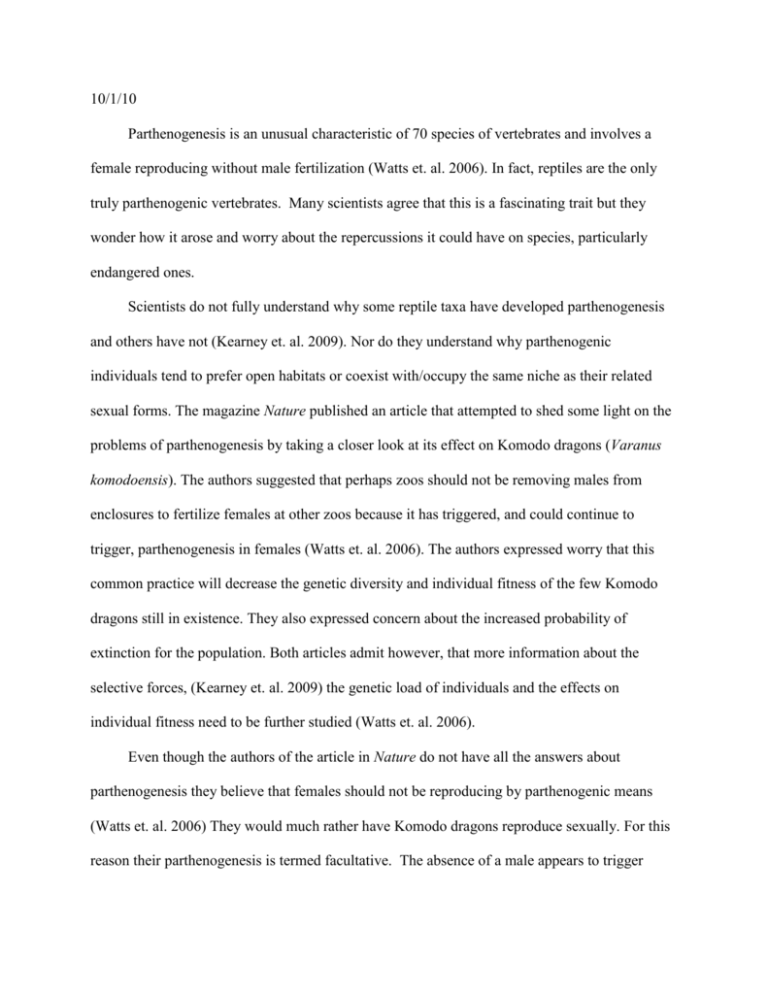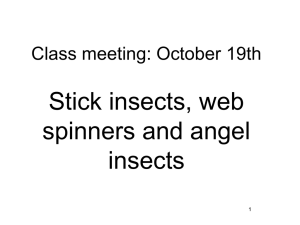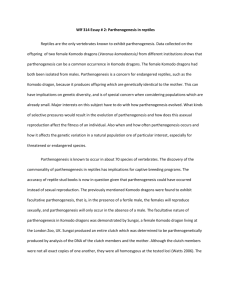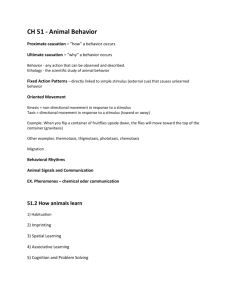10/1/10 Parthenogenesis is an unusual characteristic of 70 species
advertisement

10/1/10 Parthenogenesis is an unusual characteristic of 70 species of vertebrates and involves a female reproducing without male fertilization (Watts et. al. 2006). In fact, reptiles are the only truly parthenogenic vertebrates. Many scientists agree that this is a fascinating trait but they wonder how it arose and worry about the repercussions it could have on species, particularly endangered ones. Scientists do not fully understand why some reptile taxa have developed parthenogenesis and others have not (Kearney et. al. 2009). Nor do they understand why parthenogenic individuals tend to prefer open habitats or coexist with/occupy the same niche as their related sexual forms. The magazine Nature published an article that attempted to shed some light on the problems of parthenogenesis by taking a closer look at its effect on Komodo dragons (Varanus komodoensis). The authors suggested that perhaps zoos should not be removing males from enclosures to fertilize females at other zoos because it has triggered, and could continue to trigger, parthenogenesis in females (Watts et. al. 2006). The authors expressed worry that this common practice will decrease the genetic diversity and individual fitness of the few Komodo dragons still in existence. They also expressed concern about the increased probability of extinction for the population. Both articles admit however, that more information about the selective forces, (Kearney et. al. 2009) the genetic load of individuals and the effects on individual fitness need to be further studied (Watts et. al. 2006). Even though the authors of the article in Nature do not have all the answers about parthenogenesis they believe that females should not be reproducing by parthenogenic means (Watts et. al. 2006) They would much rather have Komodo dragons reproduce sexually. For this reason their parthenogenesis is termed facultative. The absence of a male appears to trigger parthenogenesis in Komodo dragons. Zoos did not realize this until males were removed from enclosures and the females still produced offspring. By doing genetic fingerprinting on the individuals they were able to determine that they were indeed clones of the mother. Parthenogenesis is problematic in that it immediately creates homozygosity of the entire genome which decreases the genetic diversity of the individuals. This can easily cause harm, especially in a small population where there is already limited genetics. It is also possible that since the individuals are clones they could be more easily wiped out by disease. Scientists speculate that parthenogenesis is an evolved trait because reptiles are the only truly parthenogenic vertebrates (Kearney 2009). There are many selective forces that could have caused the evolution of parthenogenesis in the Komodo dragon. One possibility is that there were uneven proportions of males to females within the Komodo dragon population. This could have been a result of chance, greater likelihood of disease in males, or any number of other reasons. As a result of the uneven sex ratio females may have begun to use parthenogenesis as a means to improve their individual fitness. Due to the fact that the only viable offspring produced through parthenogenesis are males they would also be increasing the number of mates within the population. Another possibility is that parthenogenesis was less energy intensive than the process of finding a mate. By producing offspring on their own perhaps the females could devote more time to looking for food and building body mass. Conversely it could have been a way for females to have more young. Rather than waiting for a male on every occasion, the females could mate once and then reproduce through parthenogenesis. By engaging in this behavior they could have two or three times the offspring they would have had by reproducing sexually, and therefore they would have improved their fitness dramatically. We may never know the true reason being the evolution of parthenogenesis in reptiles. Nevertheless parthenogenesis is a trait we must attempt to understand if we want to protect endangered species like the Komodo dragon. With future research and advances is science and technology we can only hope that answers to our questions about parthenogenesis will arise.








